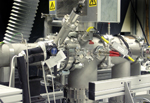Tof MS Shock Tube

Aim
Shock tubes are frequently used to study the kinetics of high temperature gas-phase reactions. A shock wave that is initiated by a gas expansion heats the reactive gas mixture within less than a microsecond to temperatures up to several thousand Kelvin. The subsequent reactions are observed by time resolved time-of-flight mass spectrometry. Thus the TOF/MS shock tube at IVG is well suited for the investigation of reactions which do not offer access by optical techniques. Of specific interest are complex reaction systems, e.g. the formation of nanoparticles from respective precursors. The measured data support the theoretical description and modeling of the particle formation processes. Thus this approach supports the design and synthesis of new materials.
Approach
The shock tube has a total length of 9.0 m an inner diameter of 80 mm. It is divided by an aluminum diaphragm (up to 0.1 mm thickness) into a driver section of 2.75 m and a driven section of 6.25 m in length. The reactive gas mixtures are prepared in a stainless-steel mixing vessel. The driver section is with He or H2 mixtures until the diaphragm breaks. The whole shock tube and the mixing vessel can be heated electrically up to 150°C to allow the study of low vapor-pressure species (e.g. metal-organic particle precursors). Shock wave speeds are observed via pressure transducers. Complex reaction systems can be studied with a high repetition-rate time-of-flight mass spectrometer. Gas samples can be taken from the gas and analyzed with a GC/MS (gas chromatograph / mass spectrometer) system. Comparable facilities are available in only two more labs worldwide.
References
Contact
Dr. Mustapha Fikri, Mustapha Fikri, Tel: +49 (0)203 - 379 3037, IVG
